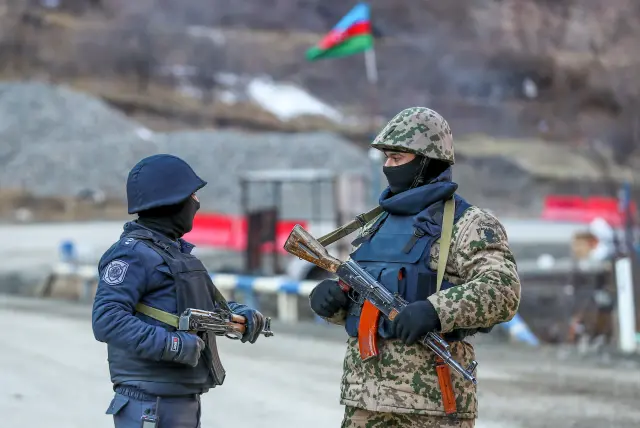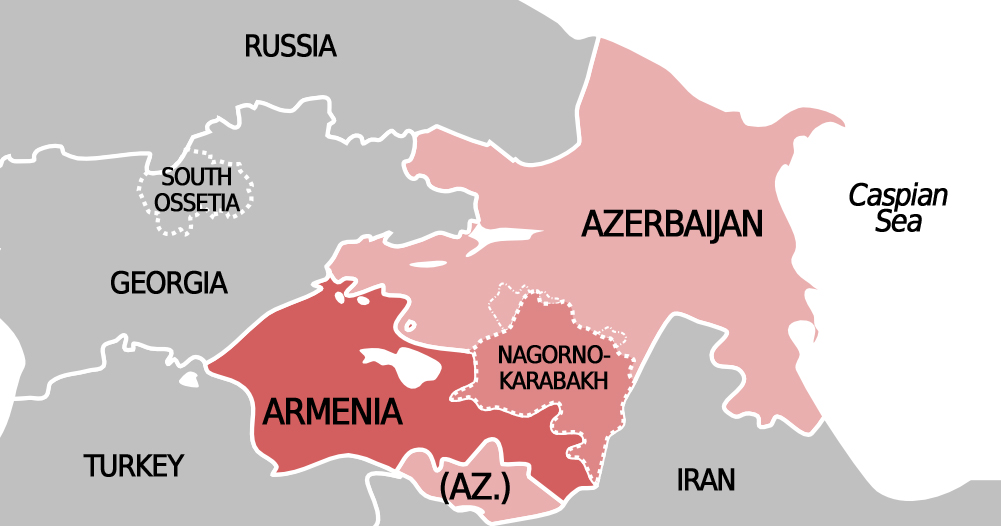
- The situation in Artsakh remains fluid as the complex scenario is impacted by geopolitical factors, ethnic tensions, and changing alliances.
- Armenia alleges that Russian peacekeepers deployed in Nagorno-Karabakh following the 2020 Karabakh war have not effectively fulfilled their duties.
- The recent ceasefire agreement, accepted by Artashk in the face of overwhelming Azerbaijani military strength and a lack of external support, is a significant development.
On 19 September, Azerbaijan initiated a military offensive in the separatist Artsakh region, referring to it as an “anti-terrorism operation.” Azerbaijani forces are advancing into Nagorno-Karabakh territory, aided by their artillery bombardment of Stepanakert, the capital of the separatist region, and other Artsakh military positions, resulting in significant damage to the capital.
The Azerbaijani military is employing substantial firepower, including artillery units as mentioned previously. Additionally, they are utilizing Turkish-manufactured Bayraktar drones for precise strikes on Artsakh positions, as well as Israeli-made drones and missiles to target cities and positions in Artsakh. Azerbaijan has publicly declared that its forces have seized and currently hold sixty Artsakh positions, and they intend to persist with their military campaign against what they refer to as “terrorists.”
On the flip side, Armenia is grappling with internal challenges.PM Nikol Pashinyan is facing significant protests against his leadership, with a substantial number of Armenians calling for his resignation and the establishment of an interim government. Yerevan, the capital of Armenia, is witnessing fiery demonstrations, with pro-Pashinyan supporters staging protests outside the Russian embassy, signalling their opposition to any Russian presence in the country. Roads are being blocked, and anti-Pashinyan demonstrators are converging near government buildings. In response, Nikol Pashinyan has taken drastic actions, deploying Armenian police to manage the protests, resulting in clashes between law enforcement and demonstrators. Police have employed non-lethal measures such as light and sound grenades to disperse the crowds.
Nikol Pashinyan and its government are scared to face any coup d’état, a high percentage of possibility for this event to happen is present and they know it really well.
Turning our attention back to the Artsakh region, the confrontations between Azerbaijani and Artsakh troops persist, marked by fluctuating levels of violence throughout the day. The Azerbaijani military continues to heavily rely on heavy weaponry, including their air force, to target their adversaries. The exact casualty count remains uncertain at this time, but there have been reports, for instance, of nine Azerbaijani fatalities resulting from a car struck by a mine.
Azerbaijan has declared that it will continue its military operation until all military structures are eliminated, issuing a warning to the Artsakh region to either surrender or face an extension of hostilities into the next day. Furthermore, during UN discussions today, Turkey offered full support to Azerbaijan in its efforts against terrorism, asserting that the region falls within Azerbaijan’s territory and that they are responsible for ensuring its security. In contrast, Iran acknowledged Nagorno-Karabakh as part of Azerbaijan but cautioned that if Azerbaijan were to invade the southern Zangezur corridor, they would intervene in the conflict and take action against Azerbaijan.
Nikol Pashinyan has made an announcement, stating that Armenia will not engage in a war with Azerbaijan to reclaim the Artsakh region and, in practice, recognise it as Azerbaijani territory. He also issued orders for Armenian soldiers not to open fire on Azerbaijani positions, although several videos depict Armenian troop movements toward the Azerbaijani border.
Reason for the conflict

The entire conflict revolves around the Artashk region, which is a self-declared entity not recognized by any other nation. This region predominantly consists of ethnic Armenians, and its current administration is pro-Armenia. Numerous Armenian separatist groups are also active in the area. However, Azerbaijan asserts territorial ownership and aims to replace the de facto leadership of the region.
Azerbaijan claims that Armenian soldiers are present in the Artashk region and have engaged in multiple instances of attacking Azerbaijani troops near the border. These actions have included suicide operations against Azerbaijani forces.
What Azerbaijan wants
Azerbaijan’s primary objective is the complete removal of the existing de facto administration in Artashk. Additionally, they insist on the complete withdrawal of Armenian troops from the region and the dismantling of its military infrastructure. Their overarching aim is to incorporate Artashk into Azerbaijan, following a “one nation, two states” policy, which envisions a close relationship between the two entities while maintaining separate territorial identities.
What has been the Armenian stance
Armenia, led by Prime Minister Pashinyan, has adopted a more conciliatory approach toward Artashk, despite its population being predominantly ethnic Armenians. PM Pashinyan in past has expressed willingness to negotiate the transfer of Artashk’s territory to Azerbaijan in exchange for security guarantees from Baku.
Armenia, under Pashinyan’s leadership, has taken a different stance towards its long-standing ally, Russia. Armenia has criticized Russia for what it perceives as inaction in Artashk. Armenia alleges that Russian peacekeepers deployed in Nagorno-Karabakh following the 2020 Karabakh war have not effectively fulfilled their duties and are withdrawing from the region. Pashinyan’s government has shifted its trust towards Western countries, exemplified by the visit of former Senate Speaker Nancy Pelosi last year and a recent joint military exercise between the United States and Armenia. This indicates Armenia’s efforts to forge new alliances.
Furthermore, Armenia has been openly critical of Russia, with Pashinyan consistently voicing anti-Russia sentiments, whether concerning Karabakh or differences within the CSTO regional grouping. Armenia has urged Russia to revoke Article 5 of the CSTO, which pertains to collective security and is analogous to Article 4 of NATO. However, Russia has been reluctant to comply with Armenian demands due to its engagements in Ukraine, as revoking Article 5 would potentially open another front, which is currently challenging for Russia.
Ceasefire between Artashk and Azerbaijan
23 hours before the start of anti-terror operations by Azerbaijan, the Artashk authority finally decided to accept the ceasefire courtesy of the greater military might of Azerbaijan. No signs of external help to Artask, the following were the proposals set by Azerbaijan to Artashk
- Armenian militias and armed formations located in the Nagorno-Karabakh region lay down their weapons;
- They leave their combat positions and military posts and completely disarm and leave the territory of Azerbaijan;
- Illegal militias are disbanded;
- At the same time, all weapons and heavy equipment are surrendered;
- The realization of these processes is ensured in coordination with Russian peacekeepers.
Artashk has decided to accept all the requests by Azerbaijan and this would mean that the territory of Artashk would be taken by Azerbaijani authority.
In conclusion, the recent ceasefire agreement, accepted by Artashk in the face of overwhelming Azerbaijani military strength and a lack of external support, marks a significant development. The terms proposed by Azerbaijan entail a disarmament and withdrawal of Armenian militias and the transfer of the region to Azerbaijani authority, all to be coordinated with Russian peacekeepers.
The situation in Artsakh remains fluid as the complex scenario is impacted by geopolitical factors, ethnic tensions, and changing alliances. The resolution of this conflict will likely continue to be a subject of international concern and diplomatic efforts in the days to come.
(The author is a post-graduate student in International Relations at Kalinga University, Raipur. Views and opinions expressed are the author’s own)
Aayush Pal is a freelance writer on contemporary geopolitical developments. The views expressed in his work are entirely his own.
